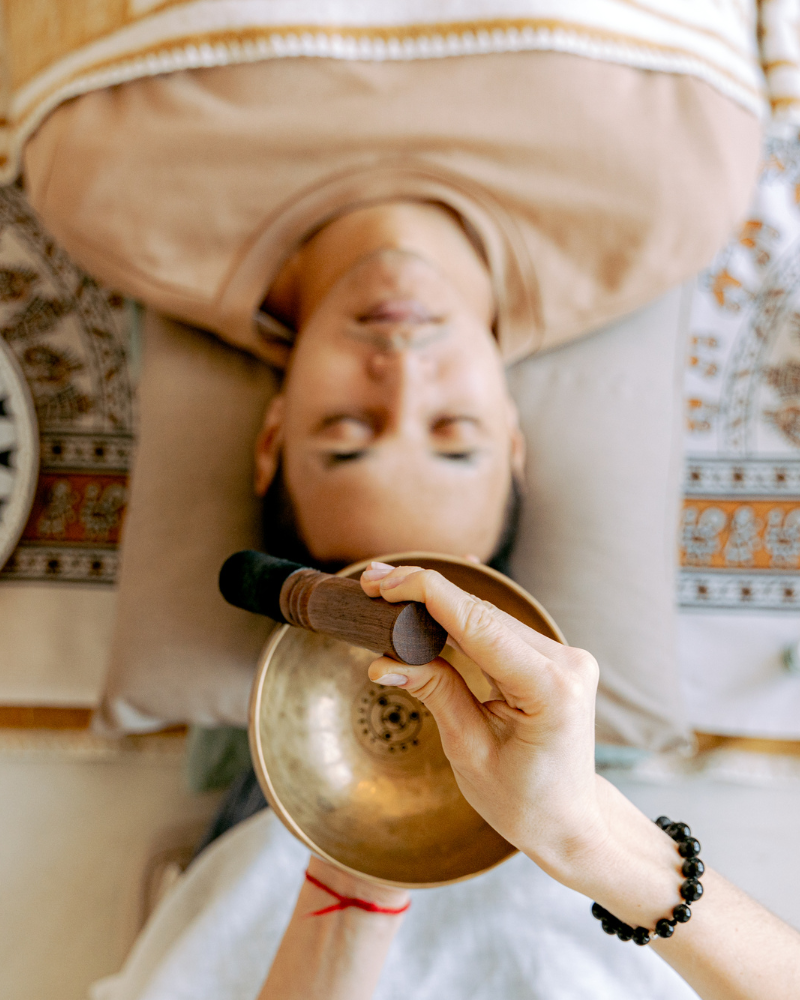On Sunday, I binged the Netflix series Apple Cider Vinegar. Based on a true story, it follows the rise and fall of Australian influencer Belle Gibson, who faked brain cancer and built a wellness empire on a lie. The series took viewers on a winding ride through themes of deception, the clash between conventional and alternative wellness, the credibility of influencers, and the murky ethics of health information shared online.
It struck a deep chord in me, touching on many versions of myself— The young intern marketing conventional medicine in big pharma. The chronic illness sufferer who once felt abandoned by the Western medical system. The seeker and student who turned to alternative wellness for answers. The marketer working with wellness brands, alternative practitioners and influencers.
I’ve stood on both extremes—deep in the corporate world of conventional medicine and immersed in the love-and-light optimism of alternative healing. And here’s what I know: marketing alternative wellness is a whole different ballgame. It’s not like selling clothes or sneakers. It’s complex. It requires nuance, emotional intelligence, and a deep awareness of the responsibility that comes with guiding people on their personal transformation journeys.
Because let’s be real—there’s a fine line between inspiration and manipulation. Between sharing wisdom and selling false hope. Between empowering people and exploiting their struggles. The wellness industry is built on trust, but in unregulated spaces, that trust can be easily broken. It only takes a few charlatans, a few exaggerated claims, a few sleazy marketing tactics to tarnish an entire industry—and to leave real people feeling misled, disillusioned, and even harmed.
So, if you’re a wellness provider, influencer, or brand navigating this space— here’s some of my personal musings on how we can market in a way that truly serves. Offering a reflection on some of the biggest problems I’ve seen as a patient and marketer. About the blind spots that can make even well-meaning practitioners unknowingly contribute to misinformation. And most importantly, how we can work together to evolve the way alternative wellness is marketed—for the betterment of everyone.

1. Alternative Wellness Will Be Misunderstood—Until It’s Not
The dominant narrative in the series? That natural therapies don’t work. That alternative wellness is dangerous. That conventional medicine is the hero, and the wellness world is full of frauds selling false hope.
Charlatans exist—I’ve encountered them myself. But let’s be real—every industry has its bad eggs. That doesn’t erase the fact that the vast majority of wellness practitioners operate with deep integrity, doing real, meaningful work. I’ve seen firsthand how these modalities help people regulate their nervous systems, heal emotional wounds, and cultivate a deeper connection to themselves.
But here’s the hard reality: “All truth passes through three stages: First, it is ridiculed; Second, it is violently opposed; Third, it is accepted as being self-evident. “ – Arthur Schopenhauer.
When you challenge long-held beliefs, introduce new ways of thinking, or break cycles, you will be the outsider—at least at first. People fear what they don’t seek to understand. And alternative wellness? It faces even more skepticism because it doesn’t have the institutional backing or billion-dollar funding to produce an endless stream of clinical studies. But let’s not mistake less funding for less value.
What this really means is that we need to refine how we communicate the value of this work—so the mainstream can begin to understand. We don’t need to villainize conventional medicine or create an “us vs. them” divide to prove our worth. There is a time, person and place for both approaches. Because the more clearly we can bridge the gap between old paradigms and new possibilities, the more people we can help in the collective.
2. Marketing Isn’t Manipulation — It’s A Medium For Meaningful Change.
Of all the people I’ve worked with, alternative practitioners seem to have the deepest resistance to marketing. There’s this deep-rooted ick—sometimes even shame—around selling their work. And I get it. We’ve been conditioned to believe marketing is manipulative—pushing messages and products onto people who don’t want them. And yeah, when it’s done that way, it is uncomfortable. It should feel off.
But marketing doesn’t have to be that. Just like you’re redefining health, I’m here to reshape the way we approach brand and communication. To me, marketing isn’t just a profession—it’s a tool for transformation. Done consciously, it has the power to raise awareness, reduce suffering, and elevate global consciousness.
The reality? There are people out there struggling—people whose lives could change if they only knew your work existed. Marketing isn’t about convincing them. It’s about connecting with them. When you focus on the right people, the right message, and the right methods—not as a game of persuasion, but as a bridge of education and service—everything shifts.
And when marketing is done in alignment with who you truly are (even in ways that honor your Human Design), it stops feeling icky. It feels natural. Because you’re not forcing anything—you’re offering something valuable to the people who are already searching for it.

3. Avoid the Savior Complex Trap — Check Your Positioning
Alternative wellness practitioners often serve a vulnerable population—people who feel unseen, unheard, let down by conventional methods, and maybe even broken. And with that? Comes a responsibility.
I know this firsthand. I spent years bouncing between conventional doctors, desperately searching for answers to a mystery chronic illness. Exhausted, gaslit, and out of options, I turned to alternative wellness as a last resort. I walked into my first energy healing session a skeptic—then woke up the next day free of chronic fatigue. From that moment, I was hooked.
But what I didn’t realize? I had just swung to the other extreme. Suddenly, these practitioners weren’t just guides—they were gurus. All-knowing. Responsible for my healing. The trust I had once placed in doctors, I now placed entirely in their hands. Without realizing it, I had fallen deep into the victim–savior dynamic.
This Savior Complex is a psychological trap that creates an unhealthy power imbalance between practitioner and client. And it’s something every wellness provider needs to be hyper-aware of—especially in their marketing and messaging. Your role isn’t to position yourself as a miracle worker. It’s to be a facilitator. Healing isn’t about rescuing people—it’s about guiding them to reclaim their own power.
Because true healing? It happens when we stop framing the vulnerable as victims and start empowering them as active participants in their own journey. The relationship should feel collaborative, not hierarchical—a space where the client takes an active role in their healing, not where the practitioner wears the cape.
4. Messaging Matters—Inspire Without Misleading
I get it—the abundance-soaked, high-vibe world of wellness is magnetic. It pulled me in, too. The promise of limitless potential, rapid healing, and quantum leaps is intoxicating. It gives people hope. But here’s the thing—hope can quickly blur into false hope when we start making promises that reality can’t cash.
Social media is flooded with bold, seductive claims: “I’ll help you manifest your dream life in 30 days.” “This method will cure your chronic illness in 3 months.” “Heal 20 years of trauma in one session.”
Sounds incredible, right? The problem is, these messages set unrealistic expectations. They sell healing as a quick fix rather than the layered, deeply personal, often unpredictable journey that it is. They attract people who are vulnerable—people who might pin their last shred of hope on something that simply can’t deliver at that speed or scale. Transformation is possible. I’ve seen it. I’ve experienced it. But it’s not linear. And it’s certainly not a one-size-fits-all timeline.
So what’s the solution? If you’re in the wellness space—whether as a practitioner or a marketer—your words hold weight. Be intentional. Be honest. Be clear. You’re not just selling a product or service—you’re shaping how people see their own healing. That’s a responsibility, not a tactic. And it deserves to be handled with care.

5. You Can’t Save The Whole World —Get Clear on your Highest Resonance Client
Alternative wellness providers often have big hearts. You see suffering and want to do everything you can to ease it. This makes choosing a niche one of the biggest points of resistance. Many struggle with thoughts like: “I just want to help everyone.” “My modality works for everything.” “I don’t want to exclude anyone.”
While this mindset feels noble, it can actually be dangerous. Without clarity, practitioners often end up working outside their expertise—supporting people they don’t have the skill or experience to truly help.
I do believe in staying in your lane. But only after a period of broad experimentation. The real issue isn’t just resistance to niching—it’s the rush to practice without enough real-world experience. The rise of quick certification culture creates a false sense of readiness. A weekend course or short training might give you knowledge, but true expertise comes from working with people, navigating complexity, and recognizing patterns over time.
That’s why I advocate for an validation phase—spending a year or more working with a diverse range of people and challenges, ideally in a beta model (offering free or discounted services in exchange for feedback). This allows you to: refine your skills, validate your methods and gain the confidence to define who and what you should and should not support with. Because true integrity? It’s not about serving everyone. It’s about knowing your strengths—and your limits.
6. The Broke Healer Archetype Isn’t Helping Anyone—It’s Time to Break It
Picture this: A practitioner running back-to-back sessions, squeezing in 12 clients a day on a pay-what-you-want model. She goes home depleted, with nothing left for her kids, her partner, or herself. She’s maxed out, yet still struggling to cover her survival needs. This is the broke healer cycle, and it’s not noble—it’s harmful.
There’s this outdated script that wellness practitioners should be self-sacrificing saints—giving endlessly, expecting little in return. But let’s be real: Being a wellness professional is a job. A profession that demands time, energy, skill, emotional bandwidth, ongoing education, and deep commitment. And like any other profession, it deserves to be compensated accordingly. Because if you want to show up fully for your clients, you first need to value your own work. You deserve to be paid—not just enough to scrape by, but enough to thrive. Enough to reflect the impact you create.
Ironically, the biggest resistance to pricing in the wellness space doesn’t always come from the outside—it comes from within. The whispers of “How dare she charge X?” The guilt trips of “If you really cared, you wouldn’t make it about money.” But let’s flip the script: Fair compensation isn’t greed—it’s sustainability.
The reality? There’s room for all price points. A $2 ebook. A mid-tier group program. A high-touch mentorship. Different offerings serve different people at different stages. The question isn’t if you should charge. It’s how you structure it in a way that honors both your clients and your capacity—so that your work can be both impactful and sustainable.

7. The Missing Piece in Wellness Certifications — Clear Communication
Training organizations that certify wellness modalities have a responsibility—not just to teach the practice itself, but to ensure students know how to communicate it clearly and ethically.
On my own healing journey, I often found myself sitting in alternative wellness trainings—not to become a practitioner, but in search of answers for myself. After weeks or months of training, I’d get handed a certificate and a “Congrats, you’re a practitioner! Go start your business. Here’s our logo for your website.” But what came next often left me uneasy.
In an alumni chat, I once saw a practitioner claiming that her subconscious reprogramming session would heal her client rapidly deteriorating from a venomous spider bite—without also suggesting she see a doctor. It wasn’t malicious, but it highlighted a bigger issue: Many practitioners aren’t taught how to communicate their work within the broader landscape of health and healing.
I don’t believe conventional medicine has all the answers, but one thing they do well? Clarity in communication. Every medication comes with clear guidelines: What it is. What it’s not. Who it’s for. Who it’s not for. How to use it. What an effective dose is. What isn’t. Yet in alternative wellness, this level of guidance is often missing.
Training organizations have an opportunity to make a real difference. By equipping students with the ability to communicate their modality responsibly, they can set clear expectations—not just for what their practice can do, but just as importantly, what it can’t. Because when practitioners aren’t taught this, they risk either overpromising and misleading—or underselling and being overlooked.
If you’re certifying someone to practice as a business, you should also be certifying their ability to communicate it properly. It’s not just about protecting practitioners—it’s about ensuring the people who seek their help get the clarity they deserve.
8. Influencer Marketing Isn’t a Free-for-All Anymore—And That’s a Good Thing
Times have certainly changed in the realm of influencer marketing, gladly. I’ve ridden the wild wild west birth of influencer instagram marketing aka. free product for post babe? but after a decade building some of the largest influencer programs for consumer brands I’ve gathered a 50+ page playbook on how to work with influencers and how to not.
In the early days, influencer marketing was a free-for-all. Brands prioritized reach over reputation, rarely conducting background checks. Creators had full creative control—often promoting products without real experience or accountability. And audiences? They had no idea they were being marketed to. #Ad wasn’t legally enforced, and transparency was almost nonexistent.
Fast forward to today, and the landscape has matured—for the better. Brands now bear a greater ethical responsibility when partnering with influencers, especially in industries like health and wellness Now, brands are: More mindful of an influencer’s professional background and credibility. More involved in the creative process to ensure alignment with brand values.
This shift benefits everyone—brands, influencers, and audiences alike. It means higher-quality collaborations, more accountability, and ultimately, greater trust. And in an era where people are more discerning than ever, that trust is the most valuable currency of all.
It’s easy for the villainization of the alternative—like what we see in Apple Cider Vinegar—to drown out the voices of healers, naturopaths, kinesiologists, life coaches, and conscious consultants. To paint alternative wellness as a world of frauds and false hope. And when that happens, it’s normal to feel defensive—maybe even to shrink. But don’t let it silence you. Let it sharpen you.
Let it be a moment to pause, not retreat. To check in with how you communicate your work. Are you sharing your truth with clarity? Are you building trust through transparency? Are you honoring the depth of what you do without overpromising—or playing into outdated guru archetypes?
Because the old narrative—alternative equals snake oil—is fading. The world is waking up. People are seeking something real, integrated, and whole—something that doesn’t force them to choose between science and soul.
And that begins with you. Own your work. Stand in your expertise. Speak with both wisdom and responsibility. Marketing isn’t just about selling—it’s about service. It’s about meeting people where they are and guiding them toward what’s possible, without manipulation or fear-based tactics.
Because the more we do this right, the less space there is for deception. And the more we create an industry rooted in truth, integrity, and transformation—for all.

